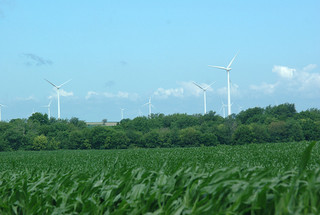REAP - the Perfect Program for Rural Renewables
By: Amos S. Eno
Posted on:04/10/2012 Updated:04/29/2012The Renewable Energy for America Program would work better if it were easier to use and more widely available.
This is a continuation from last week's post about Distributed Generation for Energy Beyond the Grid.
REAP is the Renewable Energy for America Program, which since 2003 has promoted all forms of renewable energy by providing 25% of upfront project costs on a grant basis. “It has been a very effective program in rural communities,” says Bob Belick of Sustainable Strategies. “The good news is that most agricultural producers have established relationships with USDA, the agency that administers REAP. This is critical, in our experience, because the most important element of success in getting support through this program is a strong relationship with the USDA; they can help walk you through it.”
The problem with REAP and many renewable policies, says Bob, is that they are piecemeal by state and uniformly difficult to access. “A complaint that we hear over and over from people trying to increase their energy security is that they can’t move forward, either because of the agency, the layers of review, or the time it takes to get an answer on an application.
"We could spend from three months to 1 1/2 years shepherding grant applications through REAP, and this does not include the time required for the usual construction permits. Someone has to stand up and say ‘we need to make this a lot easier for folks to utilize these incentives!’”
Certainty Begets Investment
Moreover, people in the renewables industry want a national energy strategy. Why? It’s the same mantra we hear from businesses of all types: certainty. A uniform national policy and incentives would help businesses to plan long-term.
Even with federal incentives for renewables, someone contemplating investing in a 60-turbine wind farm is looking at a nearly quarter-billion dollar investment. “Certainty about nationwide incentives and national renewable standards would make people more comfortable with those upfront investments,” says Bob.
federal incentives for renewables, someone contemplating investing in a 60-turbine wind farm is looking at a nearly quarter-billion dollar investment. “Certainty about nationwide incentives and national renewable standards would make people more comfortable with those upfront investments,” says Bob.
Right now in the US, renewable standards and programs are governed state by state. If you install solar or wind at your farm, you can sell excess energy back to the grid. But in Illinois the utility will pay you wholesale, whereas in Wisconsin you’ll get paid the retail price. “Here in Illinois,” says Bob, “Waste Management captures methane from one of its closed landfills, fueling electricity generation for two 600-kW generators; then supplies the electricity to the grid; and receives an average of $80,000/month back from the utility.”
Not as Easy for the Little Guy
Unfortunately, this is not as easy for the little guy. Federal law allows PACE, or Property Assessed Clean Energy, financing as an option for commercial, industrial, and agricultural property owners. PACE eases the pain of a large upfront investment by allowing owners to borrow the funds necessary to install renewable improvements, then pay the loan back through an assessment on their property over a period of years. However PACE financing is up to local city governments. Right now, for example, not one community in Illinois offers it!
The problem, according to Bob, has been the financial and administrative burden on local governments. “But the demand is there,” he assures me. “We had a state rebate program for renewables in Illinois in FY2012 that offered 30% of the installed cost of new facilities. Within 3 weeks of commencing the new state fiscal year, the total $1.5 million in funding was gone! And mainly to people who are ‘wired” into the system and know about the program before it hits the streets. I know one consultant who spent all day on a Sunday with his clients to get their applications for small wind and solar installations in. He only received funding for one of nine projects he submitted. In retrospect, this was an underfunded program.”
Every state has different incentives. A business that works in eight states has to put in eight times the effort to implement a renewables program. Many regions are simply behind. Wind is a burgeoning industry in Illinois, yet Bob says, “Many communities around here don’t have wind ordinances or codes for how to allow rural or individual homes to install wind power. They say they know it’s coming, but many times It hasn’t yet been addressed.”
Next week our series interviewing Bob Belick concludes with his thoughts on our upcoming "decade of decision."
Feedback
re: REAP - the Perfect Program for Rural RenewablesBy: Richard H. Day on: 04/29/2012I knew I shouldn't have opened this one after 10 pm. Oh! the webs that are woven. g'night.
 Sign In
Sign In
 Sign In
Sign In
